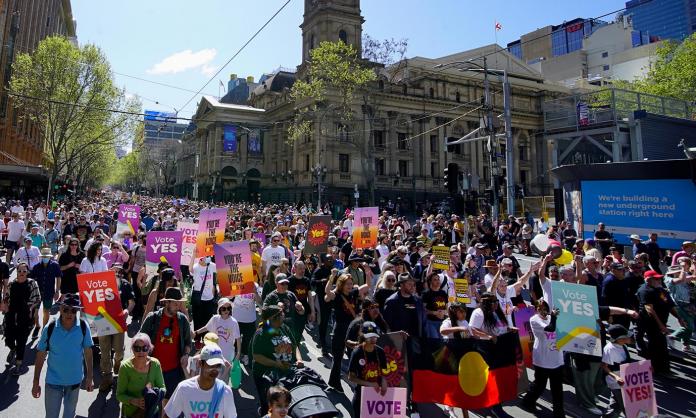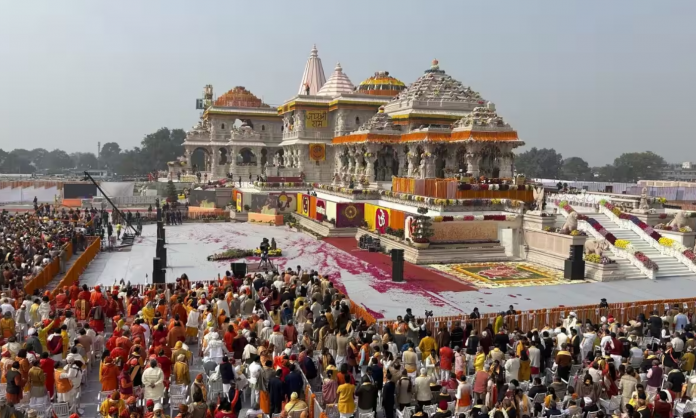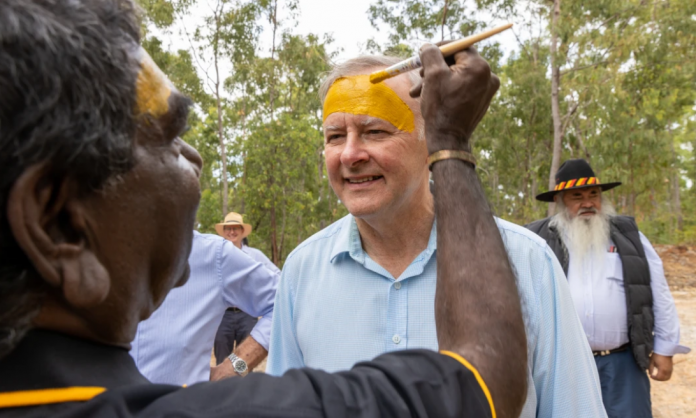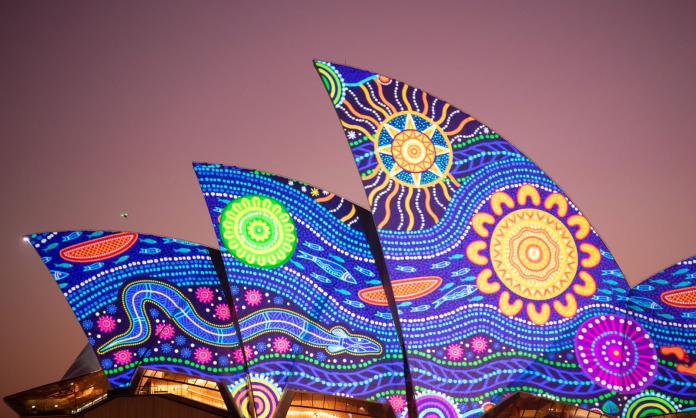In a recent National Press Club address, prominent No campaigner Warren Mundine very clearly explained what the campaign against the Voice is all about: a racist pushback against Indigenous people. Mundine wants to convince people that “most Indigenous Australians are doing fine”. He thinks that Indigenous people need to stop being “angry and aggrieved” and “trapped in the past”. Instead, they need to ignore racism and “draw a line in history and move on from a clean slate”.
This is a disgrace. Indigenous people are one of the most oppressed sections of Australian society. They suffer from appalling levels of poverty, poor health, inadequate housing and racist discrimination from employers, police, judges, government officials and politicians. But it is the acceptance of anti-Indigenous racism that is at stake in the referendum. The political right is trying to use the referendum to revive and cement the lie that Indigenous people aren’t really suffering from racism at all.
This is why, even though the Voice would be a powerless advisory body, left-wing people need to vote Yes on 14 October. Otherwise, the racist right will score a significant victory and make the fight for Indigenous rights that much harder.
Whatever the outcome on 14 October, though, we will need to keep fighting against anti-Indigenous racism. If the No campaign wins, we can’t just throw our hands up in defeat. To do so would simply deepen the demoralisation that both Indigenous and anti-racist non-Indigenous people will undoubtedly feel.
And even if the Voice were to manage to get over the line, it would do little to ameliorate the litany of racist crimes in our society. It wouldn’t stop the Queensland state government from locking up Indigenous kids and putting them in adult watchhouses. It wouldn’t stop fossil fuel companies and governments from undermining land rights. It wouldn’t compel the government to radically overhaul the way our economy condemns so many Indigenous people to a life of poverty.
The lack of any pushback against the racist right has exposed the weaknesses of the Yes campaign. When a small group of socialist activists organised a protest against a No campaign event in Adelaide, they were condemned by Anthony Albanese and Dean Parkin, the director of Yes23 for “nasty behaviour” that undermined “respectful debate.” When Marcia Langton was pilloried in the media for rightfully arguing that the arguments of the No campaign are “racist” and “stupid”, Labor and Yes23 refused to defend her.
Every day, there is a new scandal about the extreme racism in the No campaign, and the response is to lamely call for both sides to calm down, rather than slam the disgusting views of the right. All this does is play into the hands of Peter Dutton and Jacinta Price, who know they are winning without needing to be respectful.
If we are going to challenge the pervasive anti-Indigenous racism of Australian society, then we are going to need to build an anti-racist movement on a very different basis to the politics of the official Yes campaign and the Labor Party. There is a rich history of anti-racist activism in this country that we can look to for inspiration.
In the immediate post-war years, there was a wave of action by Indigenous people, and in particular Indigenous workers, against racism and discrimination. In 1946, hundreds of Aboriginal workers in the Pilbara region of Western Australia walked off the stations to protest decades of exploitation.
Trade unions from across the country supported the Pilbara strike and sent money. In Perth, which was a very racist and insular city, socialist activists hosted popular public meetings to spread awareness of the Pilbara strikers’ demands. The strike was won after three years of determined struggle by the Aboriginal workers, when the Seamen’s Union introduced a ban on wool exports from Western Australia, crippling the industry.
From 1947 to 1951, Darwin was rocked by a series of strikes by Aboriginal workers, who gained significant support from non-Indigenous workers. Trade unionists and left-wing activists in the North Australian Workers’ Union supported and helped organise the Darwin strikes.
Support for Aboriginal rights among striking post-war workers wasn’t automatic. Socialist activists, particularly in the Communist Party, had spent a decade arguing that the workers’ movement should do more to support Indigenous people and their struggles against racism.
Socialists convinced the Sydney Trades and Labour Council to endorse the Day of Mourning and Protest organised by Aboriginal activists in 1938 and managed to get 2,000 workers to attend a protest in Sydney’s Domain in 1934 to protest against police racism in the Northern Territory. Socialists carried out this activity in a time of incredible racism towards Indigenous people. In the post-war years, this activity paid off with greater levels of awareness among workers about the racist treatment of Indigenous people.
Throughout the late 1950s and early 1960s, civil rights organisations sprang up, with Communists and left-wing trade unionists often playing a role in their formation and activities. These groups organised protests against racist discrimination towards Indigenous people in rural towns and cities across Australia. Out of these struggles, they also encouraged a layer of Indigenous activists to take a leading role in the fight against racism, such as the Aboriginal Communist Ray Peckham and wharfie Joe McGinness, who became the first Indigenous president of the union’s federal council.
Building a level of awareness about Indigenous issues among workers was far from easy. Initially, it was only a very small number of highly political working-class activists who could see why standing up to anti-Aboriginal racism was important. Many workers were impacted by the racist ideas promoted at school, in the church and in the newspapers about Indigenous people being an inferior or a dying race. Many others just didn’t care very much about Aboriginal people and didn’t see why they should bother to find out about their particular struggles. Over the years, though, left-wing activists were able to use concrete examples of the racist abuse that Indigenous people suffered to educate broader layers of people about why they should stand up to racism.
This bedrock of anti-racist consciousness that left-wing activists had created meant that when there was a shift to the left in Australian society from the mid-60s onwards, there was a strong basis for support for Indigenous rights. This was then expressed in the popular support for the freedom ride of 1965, and the land rights and Black Power struggles of the 1960s and 1970s.
Today, we aren’t starting from scratch. Despite the new confidence of the racist right, there is still an established base of anti-racist opinion among a not insignificant section of the Australian population. If we are going to cohere this sentiment into the anti-racist fightback we need, then there are some important lessons that we can learn from the anti-racist campaigns of the post-war years.
These left-wing activists were clear that Australia is a racist country. “In America they call color prejudice Jim Crow. In Germany Hitler called it the ‘superiority of the Aryan race’”, explained the Communist newspaper Tribune in 1950. “In Australia we pretend it doesn’t exist, but it does exist, and at times takes as filthy and poisonous forms as it ever did under Hitler or in the lynch law Southern US States.”
These activists understood that Indigenous people aren’t just vaguely disadvantaged; they are racially oppressed.
They also understood that racism wasn’t simply a matter of prejudice. It had economic roots bound up with the whole historical development of Australian society. This was why they thought it was important to tell the truth about the history of violence and dispossession that Indigenous people had suffered since 1788. They often quoted Lenin’s statement that socialists should “react to every manifestation of tyranny and oppression, no matter where it appears, no matter what stratum or class of the people it affects” and “generalise all these manifestations and produce a single picture of police violence and capitalist exploitation”.
The Indigenous and non-Indigenous activists of that period also understood that the most effective way to combat oppression was to build a strong left-wing workers’ movement that rejected the racist lies about Indigenous people and was willing to take action to support their struggles. As the Aboriginal activist Ray Peckham put it: “The strength of the working people can help us ... crack through the curse of the color bar in Australia”.
Rather than just sinking into despair, we can look to the long history of anti-racist campaigns in Australia for clues to how we can build resistance to racism even in difficult times.











